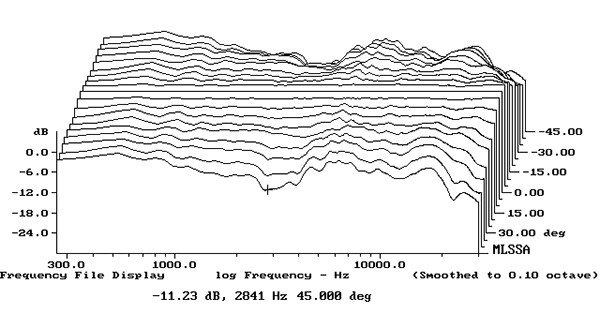boomerang
Member
- Joined
- Jan 18, 2022
- Messages
- 15
- Likes
- 5
Hi everyone, let’s start with the best regards from Holland.
First posting here, read a lot already, great forum!
Question:
In the last week, I did some measurements on my 801D4.
Glad to obtain a frequency respons quite similar to the results of HifiNews in their review.
What wonders me is why /how BW changed the output of the woofers between 90 en 400 Hz, (minus 2db) also compared to the 800D3. (As HifiNews also mentioned)
I measured the output of the low pass crossover and there could be a kind of explanation.
The transfer curve is not what I expected from a 18db Butterworth filter.
It has some bumps in its characterisic.
So maybe it isn’t Butterworth?
Coil and capacitor values also point away from a straight butterwort design.
There is a +2 dB ripple at 70hz, maybe a measuring faillure, maybe the answer?
Repeated this measurement several times, always the same result.
Btw: all of this measuring started because I wanted to try Bi amping, leaving the original cross over for mid/high (absolute top components here) but making low pass analog active, still third order at 420hz. (Since level matching will also be necessary)
But surely, that 2db ripple at 80 hz will be gone then, so what will happen with sound quality....
Exchanged MC312 for 2 x Michi M8 a month ago.
MC312 can not cope with Michi regarding low frequency power and control, but I think the Mcintosh was a little more refined in the mids/high.
So bi amping with both of them, could maybe make me even a little more happy.
Or maybe not at all...because of crossover challenges.
Should there be someone here who also did some measurements and/or knows more about the crossover layout of the 801D4, glad to hear your comments!
Update: did a verification measurement tonight on a second order passive Butterworth crossover, loaded with a test resistor of 10 Ohm.
Curve was exactly what could be expected, no ripples, -3db spot on.
So the measurement is/was valid!
Could BW deliberately have altered component values, to obtain a certain non linearity from the crossover, in order to emphasize a certain part of the frequency band?
Low pass components: From plus terminal, first coil = 2.7mH, then a set of capacitors (total 147uF) to negative terminal, followed by a 1mH coil connected to the positive terminal of the woofers.
A plain third order low pass, but with deviating component values.
Who can shed a light on this?
And am I right to presume that exchanging the passive low pass for a plain Butterworth active one, will make me lose some output in the lower frequency band in this case? (40-80Hz)

First posting here, read a lot already, great forum!
Question:
In the last week, I did some measurements on my 801D4.
Glad to obtain a frequency respons quite similar to the results of HifiNews in their review.
What wonders me is why /how BW changed the output of the woofers between 90 en 400 Hz, (minus 2db) also compared to the 800D3. (As HifiNews also mentioned)
I measured the output of the low pass crossover and there could be a kind of explanation.
The transfer curve is not what I expected from a 18db Butterworth filter.
It has some bumps in its characterisic.
So maybe it isn’t Butterworth?
Coil and capacitor values also point away from a straight butterwort design.
There is a +2 dB ripple at 70hz, maybe a measuring faillure, maybe the answer?
Repeated this measurement several times, always the same result.
Btw: all of this measuring started because I wanted to try Bi amping, leaving the original cross over for mid/high (absolute top components here) but making low pass analog active, still third order at 420hz. (Since level matching will also be necessary)
But surely, that 2db ripple at 80 hz will be gone then, so what will happen with sound quality....
Exchanged MC312 for 2 x Michi M8 a month ago.
MC312 can not cope with Michi regarding low frequency power and control, but I think the Mcintosh was a little more refined in the mids/high.
So bi amping with both of them, could maybe make me even a little more happy.
Or maybe not at all...because of crossover challenges.
Should there be someone here who also did some measurements and/or knows more about the crossover layout of the 801D4, glad to hear your comments!
Update: did a verification measurement tonight on a second order passive Butterworth crossover, loaded with a test resistor of 10 Ohm.
Curve was exactly what could be expected, no ripples, -3db spot on.
So the measurement is/was valid!
Could BW deliberately have altered component values, to obtain a certain non linearity from the crossover, in order to emphasize a certain part of the frequency band?
Low pass components: From plus terminal, first coil = 2.7mH, then a set of capacitors (total 147uF) to negative terminal, followed by a 1mH coil connected to the positive terminal of the woofers.
A plain third order low pass, but with deviating component values.
Who can shed a light on this?
And am I right to presume that exchanging the passive low pass for a plain Butterworth active one, will make me lose some output in the lower frequency band in this case? (40-80Hz)
Last edited:


